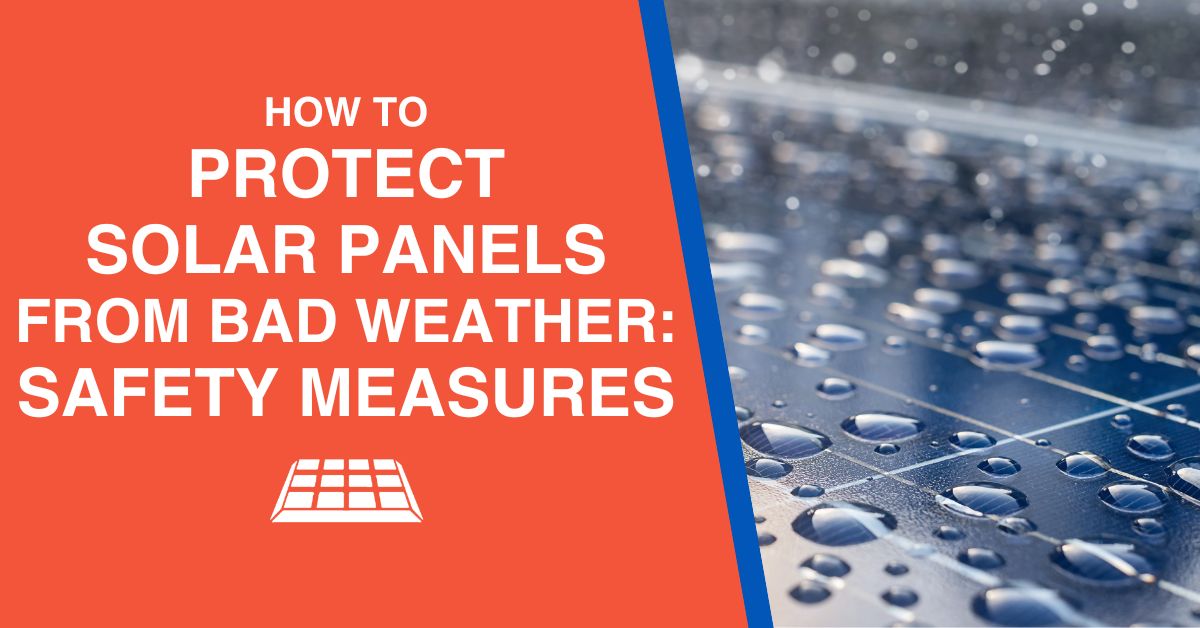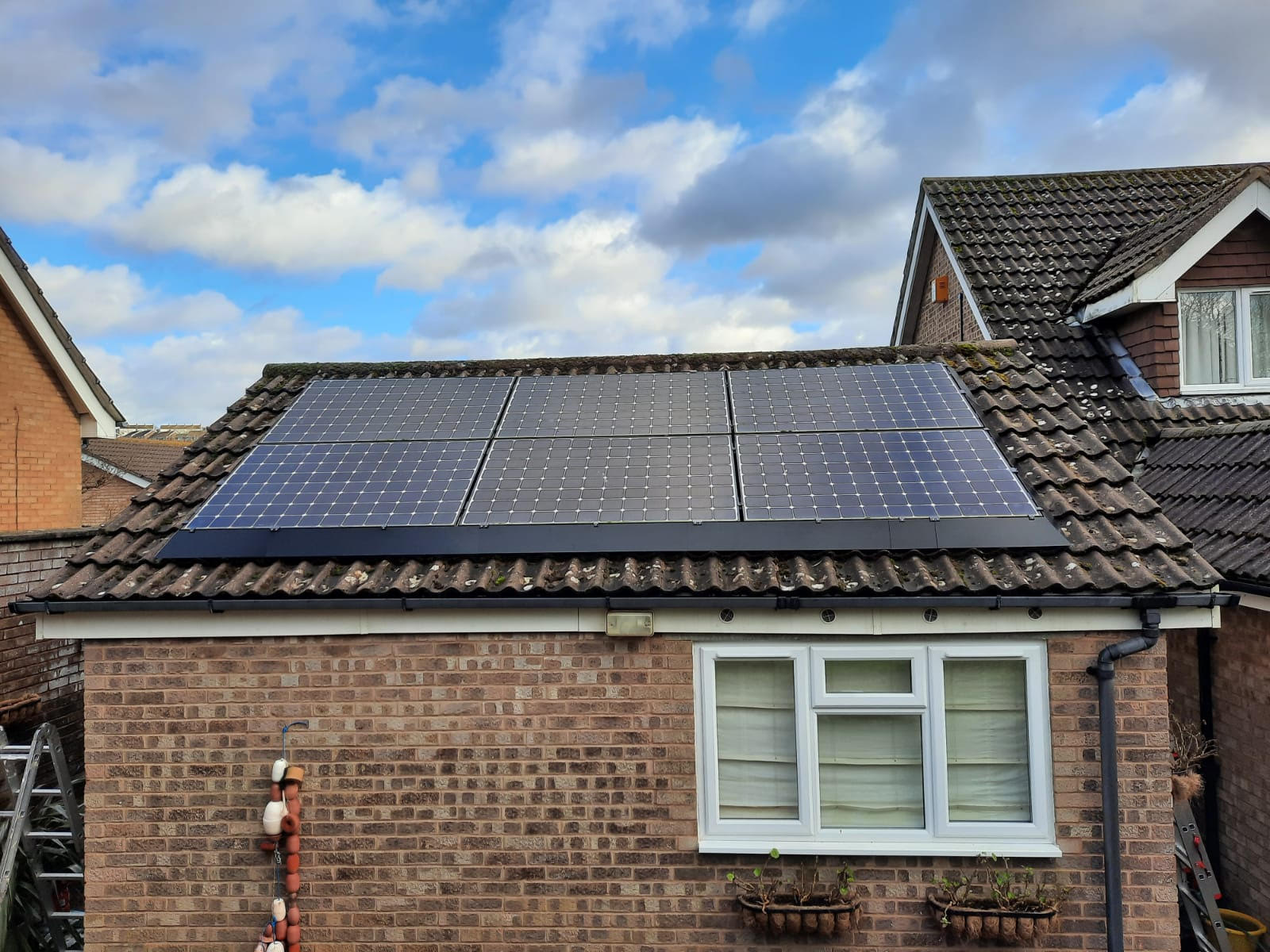
How to Protect Solar Panels from Bad Weather: Safety Measures
Solar panels are entirely waterproof and designed to withstand most weather conditions for decades. Extreme weather events, however, can cause problems.
Not only will they make your energy system less efficient. They can create actual hazards and threaten their structural integrity. So, better safe than sorry!
Here are some safety measures you should consider to protect your solar panels from bad weather.
Start with a correct solar panel installation
It’d be pointless to add screens and weather protection if your solar panels weren’t installed correctly.
They must:
- Be anchored and secured properly
- Have their nuts and bolts tightened
- Be at the right angle
This is mainly for your overall safety and to ensure they get the most sunlight. However, if you live in an area with severe weather conditions (like heavy snow), an expert would take that into consideration when installing and angling your solar panels.
Hopefully, you’ve already trusted a professional with yours. If not, we recommend getting one to check them first.
Wind protection for solar panels
Most solar panels can withstand winds of up to 140 miles per hour, but only if they’re installed properly. That’s why it’s particularly important to anchor them by securing both the actual panels and their frame.
So, follow the manufacturer’s guidelines as well as local building codes for installation. For the best and safest results, though, it’s better to hire an expert to do all that.
Once it’s done, maintenance is also key (more on that later!). When it comes to protecting your solar panels against high winds, this mainly involves checking and tightening your bolts and connections.
Snow and ice protection for solar panels
The best solution is actually quite simple. If possible, install your solar panels at an angle to create a sliding surface. That way, snow will melt and fall off more easily.
If you live in a region with particularly heavy snowfalls, on the other hand, you might need to consider additional measures. For example:
- Trim overhanging tree branches to reduce buildups of snow
- Install a pulley-operated tarp to cover your solar panels before a big snowfall (and remember to remove it afterwards, because they won’t be getting any sunlight while it’s on)
- Use a snow rake or a brush with an extension pole to remove the snow safely
Hail protection for solar panels
The actual quality of your solar panels makes the biggest difference. Hopefully, you picked sturdy solar panels with tempered glass or materials designed to withstand hail impacts.
Let’s be realistic, though: the heaviest hail storms can still cause problems. So, if they’re fairly common in your area, it’d be wiser to invest in additional protection, too. Some of your best options are:
- Methacrylate coating – Think of it as the solar panel version of your phone’s screen protector. You can spray it onto your panels to add protection against hail without affecting their efficiency. To avoid mistakes or problems with your warranty, we recommend checking with your provider first and hiring a professional
- Hail guards or panels – These will literally shield your solar panels. However, some of them (like hard shell coverings) do not let sunlight through: you’ll need to place them over your panels before a forecast hailstorm and remove them afterwards. So, they’re only really worth it if you live in an area that’s at high risk
- Mesh protection – This is a handy, permanent solution that doesn’t impact the efficiency of your solar panels (as long as it’s installed properly, at least)
Lightning protection for solar panels
You can’t really stop lightning from striking your solar panels.
The bad news is that, if it happens, it can melt your panels or their inverters. The good news? That’s extremely unlikely.
However, you might end up dealing with more common indirect strikes. These can still cause high-voltage surges and damage some components.
So, the best thing you can do is:
- Implement a robust grounding system – It’ll protect your solar panels from lightning and create the easiest path for it to move to the ground. Once again, that’s why correct installation is vital!
- Install surge protection devices – These will protect your overall system by absorbing the excess energy caused by indirect lightning strikes
Protecting solar panels from extreme temperatures
Given their very nature, you might think “the hotter, the better” for solar panels. That’s not the case, though.
Luckily, most solar panels can get up to 85°C before they stop working, but their optimal temperature is 25°C. For every degree above that, their efficiency will go down by 0.3% – 0.5%.
So, to prevent your solar panels from overheating, you should ensure proper ventilation and airflow around and underneath them.
In most cases, this means mounting them a few inches above their bottom surface. You can also spray their front with water during the hottest heat waves (but be careful: don’t mess with their frame and wires).
As for extreme cold temperatures, you won’t usually have to worry about your solar panels malfunctioning unless they reach -40°C. However, if you live in a particularly cold area, it’d be wise to include proper insulation for your electrical components and cables.
Flood protection for solar panels
Rain isn’t a problem. If your solar panels or their wires are entirely submerged by water, on the other hand, that’s not good at all. In fact, it’s a big hazard!
Extreme natural disasters aside, this shouldn’t really be a cause of concern if your solar panels are on the roof.
Either way, to protect them from floods, your solar panels must be at an elevated position and with a strong and secure mounting structure. You must also seal all electrical connections and entry points to prevent water access.
The importance of regular maintenance to protect your solar panels from bad weather
Just like it’s important to start with a correct solar panel installation, you also can’t forget about ongoing maintenance after weather-proofing them.
- Inspect your solar panel system regularly, and look for loose components and signs of wear and damage
- Address any issues as soon as possible to prevent further and more costly damage (for example, small hailstones are unlikely to break a panel that’s in perfect conditions, but they could easily make things worse for a cracked one)
- Clean your solar panels to maximise their sunlight exposure and prolong their longevity: remove all dirt, dust and debris from their surface
Other safety precautions for solar panels
These are the main ways to protect your solar panels from bad weather. Is that the most dangerous thing that can happen to them?
Believe it or not, you’re much more likely to incur damage caused by something else entirely: pigeons.
This is because they love nesting on roofs, and your warm and sheltering solar panels are the safest and cosiest place for them. What happens once they take over your energy system?
- Bird droppings aren’t just dirty and messy: they carry diseases and can cause health risks. They’re also corrosive and can damage your solar panels in the long run
- From droppings to nests, birds can reduce your solar panel efficiency by up to 30%
- They can also damage your solar panels by chewing or dislodging their wires. This, together with the dry and combustible materials they use for nesting, is a big fire hazard
- On top of that, having birds nesting underneath your solar panels can get loud and irritating (imagine them cooing and scurrying around on your roof when you’re trying to sleep)
So, what can you do about it?
Just like you’d protect your solar panels from bad weather, you should protect them from vermin, too.
The best option is to bird-proof your solar panels with mesh wire. This covers their entire perimeter without ruining your house aesthetics. It’s also extremely effective, safe and made to last.
You can buy high-quality mesh, but for the best long-term results (and to avoid injuring yourself in the process), you should let a professional do it. At Pigeon Proofing Solar Panels, that’s exactly what we specialise in!
Keeping your solar panels in excellent condition and protecting them from bad weather and vermin
Your solar panels were a considerable investment. So, it only makes sense to put something in place to protect them and help them last as long as they should.
If you DIYed everything so far, we recommend consulting with a professional solar panel installer or engineer. They’ll check if your system was designed and installed properly (and in a way that can withstand your local weather conditions) and fix it if that’s not the case.
And if you had never thought about pigeon-proofing before, spare yourself from additional expenses and headaches: do something about it before some birds turn your solar panels into their new home. Get in touch with Pigeon Proofing Solar Panels today.
<- Back to blog

